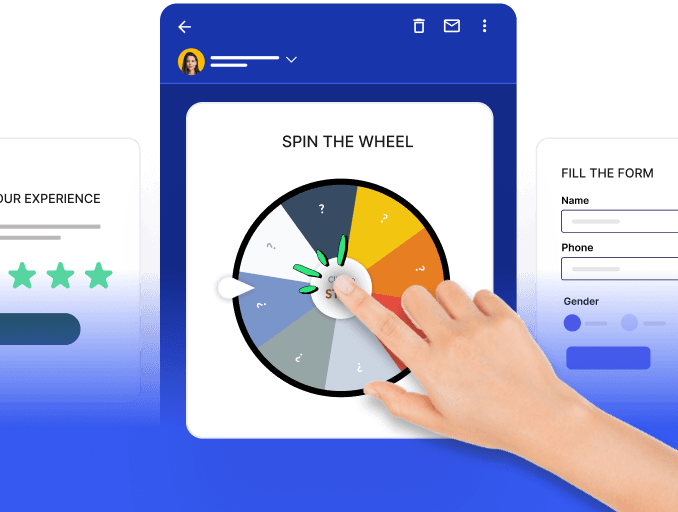Email marketing automation allows businesses to streamline email campaigns, save time, and deliver personalized content to their subscribers. It enables you to create automated workflows triggered by specific events or actions, such as form submissions or website interactions. By leveraging email marketing automation, you can nurture leads, onboard new customers, and engage with your audience at scale.
When you're setting up email automation for your campaigns, there are certain things that you need to take care of. In this comprehensive guide, we'll walk you through the top email marketing automation best practices to help you take your email campaigns to new heights.
Table of contents
14 Email marketing automation best practices to follow
- 1. Plan the workflow ahead of time
- 2. Set goals for each workflow
- 3. Balance automation and personalization
- 4. Mix and match the kind of content
- 5. Use hyper-personalization
- 6. Use triggers
- 7. Use email service providers (ESP)
- 8. Test and optimize your campaigns regularly
- 9. Offer easy opt-outs
- 10. Make use of customer journeys
- 11. Optimize for mobile devices
- 12. Use interactivity in your emails
- 13. Segment your audience effectively
14 Email marketing automation best practices to follow
Here are 14 email marketing automation best practices to keep in mind:
1. Plan the workflow ahead of time
Before diving into building automated email workflows, take the time to plan and identify the right triggers for each workflow. Understand the goals you want to achieve with your workflows and the target audience for each workflow. This planning process ensures that your efforts align with your objectives and helps you allocate resources effectively.
Create a visual representation of each workflow, mapping the flow and branching paths. This helps you understand the logic and complexity of your workflows before diving into the automation software. By planning your workflows, you can ensure a smooth and efficient implementation process.
2. Set goals for each workflow
To measure the success of your automated workflows, it's important to set goals for each workflow. Determine what actions or outcomes you want to achieve with each workflow and set corresponding goals. By setting goals for each workflow, you can track the progress and effectiveness of your automated emails.
For example, if you have a workflow for onboarding new customers, your goal may be to have them complete a specific action, such as downloading a resource or purchasing.
3. Balance automation and personalization
While automation is essential for scaling your email marketing efforts, balancing automation with personalization is important. Avoid sending generic, one-size-fits-all emails to your subscribers. Instead, use your collected data to personalize your email content, subject lines, and sender's name. This level of personalization makes your emails feel more relevant and tailored to each recipient.
4. Mix and match the kind of content
To keep your subscribers engaged, mixing and matching the content you send in your email campaigns is important. Avoid sending repetitive or monotonous emails. Instead, experiment with different types of content, such as educational articles, case studies, videos, or infographics.
Be consistent with your emails and workflows' design, tone, and structure to maintain brand consistency. However, introduce new elements or variations to keep your emails fresh and interesting. You can capture your subscribers' attention and drive engagement by delivering diverse and valuable content.
5. Use hyper-personalization
Hyper-personalization takes personalization to the next level by leveraging dynamic content. Use dynamic emails that automatically adapt to each recipient's preferences, behavior, or past interactions. Customize your email content based on real-time data, such as recent purchases, browsing history, or location.
Hyper-personalization requires you to analyze customer data using AI and advanced machine learning algorithms to deliver highly relevant, tailored content that resonates with them. You can increase engagement and drive conversions by speaking directly to their needs and interests.
6. Use triggers
Triggered emails are automated emails sent in response to specific actions, events, or triggers. These actions include form submissions, website visits, or abandoned shopping carts. By automating these emails, you can deliver highly relevant content to your subscribers, enhancing their overall experience with your brand. These triggered emails guide your subscribers through their customer journey.
For example, if a subscriber abandons their shopping cart, you can automatically send them a reminder email with a special offer to encourage them to complete their purchase. Similarly, if a subscriber signs up for a webinar, you can send them a confirmation email with all the necessary details.
7. Use email service providers (ESP)
Email service providers (ESPs) offer robust automation capabilities and pre-made templates, making designing and implementing your email campaigns easier. Choose an ESP that aligns with your business needs and provides the features and integrations required for effective email marketing automation.
When choosing an ESP from the options available, look for one that offers an easy-to-use workflow builder to make setting up automation a breeze.
8. Test and optimize your campaigns regularly
Email marketing automation provides valuable data and insights that can help you optimize your campaigns over time. Regularly test different elements of your emails, such as subject lines, call-to-action buttons, and email design, to identify what resonates best with your audience.
A/B testing is a powerful tool that allows you to compare different versions of your emails and determine which performs better. There are three points to keep in mind:
Be sure to test them before sending
Analyze and monitor the performance of each workflow
Schedule maintenance so that any problems can be fixed
Pay attention to key metrics such as open rates, click-through rates, and conversion rates to gauge the effectiveness of your campaigns. Use this data to make data-driven decisions and continuously improve your email marketing strategy. Regularly testing and optimizing your campaigns ensures you deliver the most engaging and effective content to your subscribers.
9. Offer easy opt-outs
Respect your subscribers' preferences and provide them with an easy opt-out option. Allow them to unsubscribe from your emails or set their email preferences to receive only specific types of content. This shows you value their choices and helps maintain a positive relationship with your subscribers.
By offering easy opt-outs, you can also ensure that your email list consists of only the interested subscribers, improving your campaigns' overall deliverability and effectiveness.
10. Make use of customer journeys
Customer journeys map out the different phases or touchpoints a customer goes through during their interaction with your brand. Understanding these touchpoints allows you to deliver the most relevant emails based on each customer's phase or stage. This ensures that your emails are timely and aligned with your customer's needs and interests.
For example, if a customer has purchased, you can send them a follow-up email with related product recommendations or exclusive offers.
11. Optimize for mobile devices
With the increasing use of smartphones and tablets, optimizing your email campaigns for mobile devices is crucial. Ensure that your emails are mobile-responsive and display correctly on different screen sizes. Use a responsive email template that automatically adjusts the layout and font sizes to provide an optimal viewing experience for mobile users.
Keep your email designs simple and easy to read on smaller screens. Use clear and concise subject lines, avoid long paragraphs, and use bullet points or numbered lists to improve readability. By optimizing the responsiveness of your emails for mobile devices, you can ensure that your subscribers can easily engage with your content, regardless of the device they are using.
12. Use interactivity in your emails
Interactivity is a powerful way to engage your subscribers and make your emails stand out. Incorporate interactive elements such as polls, quizzes, sliders, or GIFs into your emails to encourage active participation. Interactive emails create a more immersive and engaging experience for your subscribers, increasing the likelihood of click-throughs and conversions.
Consider leveraging AMP (Accelerated Mobile Pages) technology in your emails. AMP emails allow users to interact with the email content, such as submitting forms or providing feedback without leaving their inbox.
**
Get a sample AMP email in your inbox
Experience the power of interactivity right now
**
13. Segment your audience effectively
Segmentation is a crucial aspect of email marketing automation. By dividing your audience into specific segments based on demographics, behavior, or preferences, you can send relevant emails to segments that may be interested in the emails. This ensures that your emails are relevant and valuable to your subscribers, leading to higher open rates and engagement.
Conclusion
Implementing these email marketing automation best practices will give you a competitive edge. Remember that email automation is about building and nurturing relationships. It can lead to increased not only productivity but also stronger, more meaningful connections with your subscribers. By following these best practices, you can take your email marketing automation to the next level and drive meaningful results from your email campaigns.







